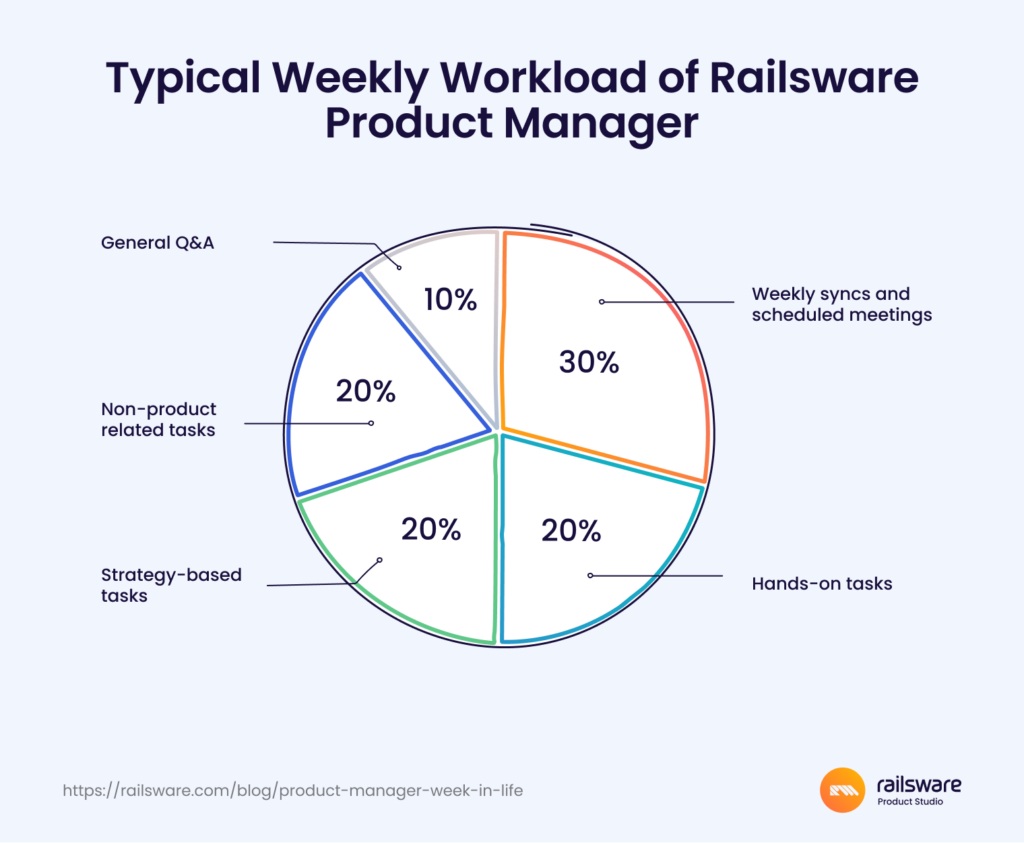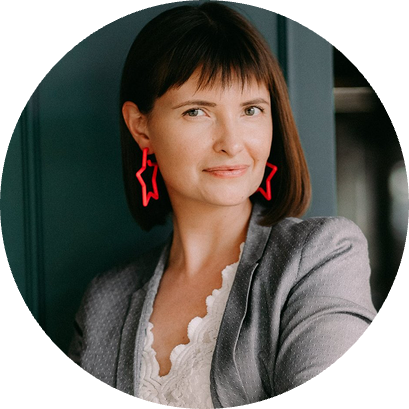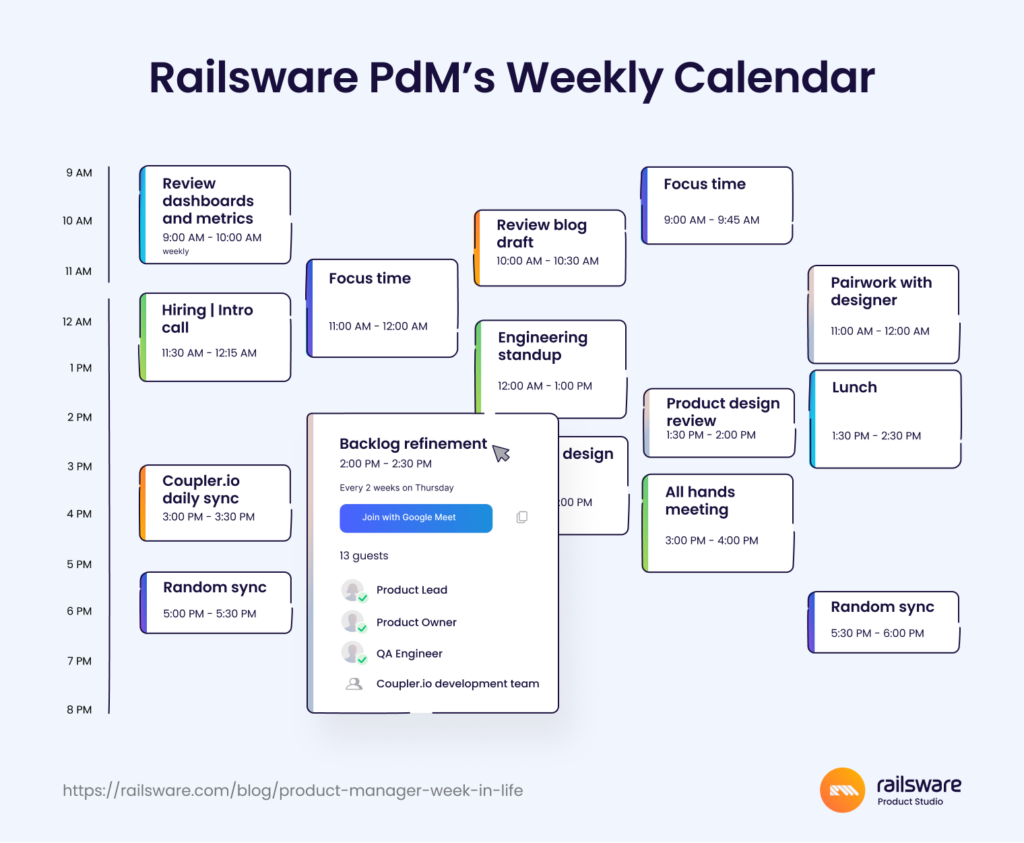We’ll answer questions like what does a product manager do at Railsware? How much time do they spend planning or attending meetings each week? Who do they collaborate with daily? And how do they organize their workload, manage their time, and maintain a good work-life balance?

Meet our Product Lead, Julia Ryzhkova
Julia Ryzhkova is the driving force behind Railsware’s Coupler.io, a data automation and management platform. She also leads the team working on our client’s product, Tradezella.
Julia’s been a Product Lead at Railsware for 3 years, but she’s spent the past 15 years working within the product development realm. In that time, she’s held senior roles in product management, managed several large teams, and dabbled in the disciplines of business analysis and customer experience. On top of her full-time job, Julia is a long-time Visiting Lecturer at Lviv Business School, where she runs a course on ‘Business Process Modeling.’
Product Lead role at Railsware
Before we dive into a typical week for Julia, let’s start with a brief description of the role. Bear in mind that the roles of Product Lead and Product Manager (PdM) at Railsware are quite similar from a day-to-day perspective, although Product Leads have more authority and responsibility within the product context. So, broadly speaking, the core responsibilities of our Product Leads and PdMs include:
- Defining the product vision, creating a development strategy, and managing the product roadmap.
- Managing the product life cycle, from ideation and prototyping to MVP development and new product launch.
- Tracking product metrics and using the insights gathered to make data-informed decisions.
- Conducting both quantitative and qualitative research (e.g. competitor analyses, CustDev interviews, surveys) to better understand customer needs and improve user experience.
- Analyzing industry and customer data (product dashboards, user research, market analyses) to identify opportunities for growth or new products.
- Regularly collaborating with cross-functional specialists to create and approve product assets (e.g. new designs, features, integrations, marketing initiatives).
- Peripheral activities such as hiring, mentoring, documenting repeatable processes, etc.
At Railsware, our distributed cross-functional teams are self-managing. Team members don’t rely on a leader to allocate tasks or validate their work. Instead, they organize and prioritize their workloads according to current project objectives.

Sergiy Korolov
Managing Director at Railsware
At Railsware, product managers are sort of like spiders at the center of a product ‘web.’ They collect information from all corners of that web – engineering, design, marketing teams – and use those insights to shape the product vision, design new features, or solve complex problems.
With all of that in mind, let’s get back to Julia, and explore what an average week looks like for her.
Railsware product manager’s weekly activities
It might sound like a cliche, but every day is different for a product manager at Railsware. Sure, you’re working on the same couple of projects and collaborating with the same people for weeks at a time. But low-level priorities are constantly shifting, and you can’t always anticipate what kind of support your clients, customers, or team will need each week.
That’s why we decided against ‘a day in the life’ format for this article. Rather than give a Monday-Friday breakdown, we’ve distilled Julia’s weekly activities into 5 categories:

Before we dive into each category, let’s look at how Julia usually begins her workday.
Morning routine
Although no two days are exactly the same, Julia usually starts the morning by reviewing her calendar. This ritual is more than just a passive assessment of upcoming Calendly events (e.g. client meetings, product onboarding calls) and internal meetings. It’s also an opportunity for Julia to prioritize her to-do list and schedule time for must-priority tasks. For example, she might schedule 15 minutes to provide feedback on a new design in Figma, or 30 minutes to review a blog post.
Julia also takes full advantage of the ‘Remind me’ Slack feature. Every morning, she checks the messages she set reminders for yesterday (typically questions from the team). If she can’t answer a question without doing some intensive research or data analysis, she schedules time in her calendar for that too.
Don’t be afraid to block time in your calendar for deep work. For me, it’s essential to have 2-3 hours of ‘focus time’ a day, otherwise, it’s hard to get any actual tasks done. Blocking the hours in my calendar ensures I won’t be interrupted by impromptu calls (although the team knows they can always reach out async if needed).

Julia Ryzhkova
Product Lead at Coupler.io
Regular meetings (30%)
Not all meetings in a PdM’s calendar are created equal. Let’s break down the different types of meetings Julia might have in a week:
- Product development-related meetings are team meetings that we have modeled on agile and scrum practices. Most of them happen bi-weekly (Backlog Refinement, Iteration Planning, Team Demo) or once a month (Coupler.io/Tradezella Retrospective, Product Scope Review), and are led by Julia or Coupler.io’s Product Director, Olexander Paladiy. Some meetings, like the Team Demo, will have 30+ attendees, including specialists from the QA, support, marketing, and development teams. Others, like Backlog Refinement syncs for Coupler.io, are led by the product management team and attended by the dev team only.
- Product team collabs are product-related meetings with a narrower focus and fewer attendees. For example, there are daily development team standups, weekly syncs with the Coupler.io sales team, twice-weekly product design reviews, and bi-weekly product analytics reviews. Julia may not be an active participant in all of them, but attending these meetings allows her to stay up-to-date with each product function’s goals, successes, and struggles.
- Pair work with designers and marketers. Pair programming is something our engineering team practices regularly, but we also do pair work in our other product functions. During these collabs (1-2 hour meetings) Julia will work closely with a marketer or product designer to review/create materials like content plans, landing pages, ad campaigns, or clickable feature prototypes in Figma.
- Ad-hoc meetings are unplanned, one-on-one Slack calls (or short GMeet calls) initiated to solve a problem or close a task quickly. Julia might have these types of calls with a QA who’s struggling to understand the context behind a task, an analytics engineer who’s spotted a problem with a product dashboard, or an engineer who wants to bring a recurring bug or feature error to her attention.
- Customer support calls for Coupler.io can include onboarding walkthroughs or meetings with prospects (e.g. large enterprise) where Julia expands on the benefits of Coupler.io as it relates to the prospect’s specific needs.
- Occasional meetings are monthly, bi-monthly, or quarterly meetings that aren’t directly related to product development. For instance, each company-wide guild (i.e. function: product management, marketing, etc.) holds a monthly meeting to discuss team achievements and share industry knowledge. Every four months, Julia will also attend our company All-Hands, and even participate in some product-related presentations during that meeting.
Hands-on tasks (20%)
We often talk about our product managers being ‘hands-on,’ but what does it actually mean? For Julia, hands-on tasks include reviewing metrics and dashboards to dig up new insights, managing the roadmap and backlog (which may involve sharing context with stakeholders or creating user stories), and creating rudimentary designs in Figma.
But hands-on also refers to the grunt work of preparing for those tasks. Before being able to prioritize and document requirements, she needs to gather insights from different team specialists and draw conclusions from the findings. Before pairing with a product designer to create wireframes, she must review feature requirements and understand how certain design choices might impact current/future customers.
Strategy and planning (20%)
When Julia isn’t doing hands-on tasks or attending meetings, she’s analyzing where the product currently stands and planning for future changes.
More specifically, she’s conducting market, customer, and competitor research to uncover new directions for product growth. Or again, she’s checking revenue, marketing, sales, and customer support dashboards to get a full picture of how well the product is performing on the market. Then there’s always the next iteration to plan for, feature requests or team inputs that must be reviewed and prioritized, and future product updates to map out.
Planning activities are closely tied to other activities we’ve mentioned, like feature prioritization, customer development, market research, and team collaborations. At Railsware, PdMs create plans and manage their implementation (on a high level). But they rarely strategize alone. For example, when teasing out an idea for a new feature, or brainstorming a new marketing approach, Julia typically brings a few specialists from the team together for a BRIDGeS session.
At Railsware, the influence and responsibilities of PdMs extend beyond a product manager’s conventional scope.
- Hiring activities. Product managers aren’t responsible for hiring new team members (we’ve got a whole HR team for that). However, when we are hiring for ‘Product’ positions, such as Product Lead or Product Support Specialist, Julia actively participates in the process. She’ll check candidate test tasks and also attend Intro Calls/Pair Interviews/Half-Day collaborations.
- Knowledge sharing. Like many other Product Leads/Managers at Railsware, Julia regularly contributes to campaigns and projects outside of her day-to-day scope. Take technology conferences, for example. Julia has represented Coupler.io at events like Web Summit, where she’s pitched the benefits of our product and networked with other product leaders.
- Team support. Again, as a Product Lead, Julia provides occasional, professional support to her teammates: answering questions, giving feedback, etc. But there’s more to her support role than that. For example, each full-time Railswarian (including Julia) has an Individual Development Plan (IDP), designed to help them grow within the company and shape their career path. IDP sessions are led by HR specialists and coordinators from different projects. Julia acts as a coordinator for a few of her teammates, attending sessions and providing ongoing guidance throughout the year.
General Q&A (10%)
PdMs are the central knowledge holders within a product context. As such, Julia expects to spend a few hours throughout the week fielding questions from different product stakeholders: engineers, marketers, QAs, analytics engineers, c-suite management, other product managers/leads, and more.
Not all of those questions are complex or urgent. It might be a request from a designer for feedback on a feature prototype, an engineer asking for more context about a particular task on the Jira board, or a support specialist checking which materials they can share with a customer.
She’s also a touchpoint for our client Tradezella, and addresses any questions or concerns the team may have during the week.

End-of-week routine
When we asked Julia if she has a Friday wrap-up routine, she explained that she’s never needed one. Instead, she takes 15 minutes on a Monday morning (before meetings or answering messages) to review the Jira board, Slack notifications, emails, and of course, her calendar. With that, she’s ready to jump back into the week and continue working on any outstanding tasks.
A couple of frameworks that help Julia stay on top of her weekly workload are the Urgent-Important Matrix and the MoSCoW prioritization framework. Depending on the project or issue at hand, she’ll use either framework to reassess her priorities and make sure she’s delegating where possible.

Julia Ryzhkova
Product Lead at Coupler.io
Prioritization, time management, and a willingness to delegate are key. Life at Railsware is fast-paced, but we don’t treat every task like an emergency. We prefer to work on things we need tomorrow – not yesterday.
Maintaining a work-life balance
When we asked Julia how she maintains a healthy work-life balance, she highlighted her flexible schedule. Usually, Julia’s working day begins at 9 a.m., but she opts for a later start when personal commitments (like doctor appointments) pop up. And it’s not just about having time to do the boring, essential stuff. For Julia, having a flexible schedule also allows her to spend more quality time with her loved ones.
Some days are more energy-consuming than others. It’s rare, but when I need to spend a few extra hours in the evening dealing with a work issue, I know I can take time the next day to decompress. The last time that happened, I went for a walk in the park the next morning with my daughter, and it was perfect.

Julia Ryzhkova
Product Lead at Coupler.io
Ensuring clients (and teammates) know when she isn’t available also helps. At Railsware, everyone is entitled to 34 days of paid time off (PTO) annually – and we encourage people to use up their days.
So, whenever Julia wants to take planned time off, she marks it in both the Railsware and client calendar some weeks in advance. For the Tradezella project, the Railsware team even has a Gantt chart that displays the PTO of all team members, so it’s easy for the client to see who’ll be off, and when.
Final thoughts
Candidates interviewing for our product management roles often ask: What does a typical day at Railsware look like? As you can probably tell, there’s no straight answer to that question. In many ways, the role of a product manager is unpredictable and ever-changing – but that’s what Julia loves the most about her job. Some weeks, she’s working on an ambitious new project, or simply making sure the product is in good health. Other weeks, she’s hosting a workshop at a hackathon, representing Coupler.io at an international conference, or even jetting off to the Mediterranean for a well-deserved vacation. As they say, variety is the spice of life!